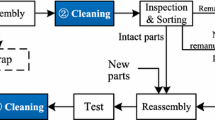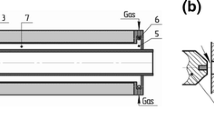Abstract
Perfluorinated compounds (PFCs) increasingly utilized in electronic manufacturing represent a potent source of global warming effect. Because of extremely high stability of PFCs only very high temperature is effective for their destruction. Thermal plasma offers higher destruction and removal efficiency as compared to conventional methods allowing to reach sufficiently high temperature as well as suitable conditions, including high enthalpy and reactive environment for destruction even of the most persistent PFCs. The aim pursued by this work is to apply water and gas stabilized DC-plasma torch for generating steam plasma for efficient abatement of the most persistent PFC, i.e., CF4, and to observe a dependence of destruction and removal efficiency on operational conditions, including concentration of CF4, input arc power of the plasma torch and an influence of an additional gas. The experiments were carried out at 20 kW and 40 kW of torch power in the concentration range 1–20% of CF4 in mixture with both nitrogen and argon and total feed rate 50 L/min in plasma chemical reactor. The mixture with argon exhibit considerably higher destruction efficiency than that with nitrogen. The highest destruction efficiency was attained in the mixture CF4/argon at 40 kW of torch power. Among other gases (CO2, O2, H2) added to CF4 the only hydrogen exhibited a positive effect to destruction performance. It was found an optimal feed rate of additional hydrogen corresponding to the maximum of destruction efficiency.







Similar content being viewed by others
References
Available at IPCC Fourth Assesment Report: Climate Change (2007) Direct global warming potentials. https://archive.ipcc.ch/publications_and_data/ar4/wg1/en/ch2s2-10-2.html. Accessed 17 Jun 2019
O’Hagan D (2008) Understanding organofluorine chemistry. An introduction to C-F bond. Chem Soc Rev 37:308–319
Abe H, Yoenda M, Fujiwara N (2008) Developments of plasma etching technology for fabricating semiconductor devices. Jpn J Appl Phys 47:1435–1455
Seeley A, Chandler P, Cotte S, Mawle P (2000) Effective PFC gas abatement in a production environment semiconductor. 10th ed Fabtech
Worton DR, Schwander J, Sturges WT et al (2007) Atmospheric trends and radiative forcings of CF4 and C2F6 inferred from firn air. Environ Sci Technol 41:2184–2189
Gibbs MJ, Bakshi V, Lawson K, Pape D, Dolin EJ (2002) PFC emissions from primary aluminium production. IPCC. https://www.ipcc-nggip.iges.or.jp/public/gp/bgp/3_3_PFC_Primary_Aluminium_Production.pdf. Accessed 8 Nov 2019
Non-HCFC refrigerant mixture for an ultra-low temperature refrigeration system. US Patent. 6631625B1
Kyoto protocol homepage. http://www.kyotoprotocol.com/. Accessed 18 Jun 2019
The Paris Agreement. https://unfccc.int/process-and-meetings/the-paris-agreement/the-paris-agreement. Accessed 18 Jun 2019
Regulation (EU) No 517/2014 of the European parliament and of the Council (2014) Official Journal of the European Union L 150/195–L 150/230
https://ec.europa.eu/clima/news/eu-ratifies-kigali-amendment-montreal-protocol_en. Accessed 18 Jun 2019
Reduction of Perfluorocompound (PFC) Emissions: 2005 State-of-the-Technology (2005) Report Technology Transfer #05104693A-ENG International SEMATECH Manufacturing Initiative
ODS destruction (2009) ICF International for U.S. EPA’s Stratospheric Protection Division
Kawai Y, Ikegami H, Sato N, et al. (eds) (2010) Industrial plasma technology. Wiley, Hoboken, chap.6, pp 69–77
Heberlein J, Murphy AB (2008) Thermal plasma waste treatment. J Phys D Appl Phys 41:053001
Hrabovský M (1998) Water-stabilized plasma generators. Pure Appl Chem 70:1157–1162
Hrabovský M, Kopecký V, Sember V, Kavka T, Chumak O, Konrád M (2006) Properties of hybrid water-gas DC arc plasma torch. IEEE Trans Plasma Sci 34:1566–1575
Hrabovský M (2011) Steam plasma flows generated in gerdien arc: environment for energy gas production from organics and for surface coatings. J Fluid Sci Technol 6:792–801
Deam RT, Dayal AR, McAllister T et al (1995) Interconversion of chlorofluorocarbons in plasmas. J Chem Soc Chem Commun 3:347–348
Murphy AB, Farmer AJD, Horrigan EC, McAllister T (2002) Plasma destruction of ozone depleting substances. Plasma Chem Plasma Process 22:371–375
Narengerile Saito H, Watanabe T (2010) Decomposition mechanism of fluorinated compounds in water plasmas generated under atmospheric pressure. Plasma Chem Plasma Process 30:813–829
Chen SH, Živný O, Mašláni A, Chau SW (2019) Abatement of fluorinated compounds in thermal plasma flow. J Fluorine Chem 217:41–49
Pyrogenesis (2019) https://www.pyrogenesis.com/products-services/plasma-waste-processes/sparc/. Accessed 19 Jun 2019
Lee HM, Chen SH (2017) Thermal abatement of perfluorocompounds with plasma torches. Energy Proc 142:3637–3643
Hlína M, Hrabovský M, Kavka T, Konrád M (2014) Production of high quality syngas from argon/water plasma gasification of biomass and waste. Waste Manag 34:63–66
Hrabovský M, Hlína M, Kopecký V et al (2017) Steam plasma treatment of organic substances for hydrogen and syngas production. Plasma Chem Plasma Process 37:739–762
Hrabovský M, Hlína M, Kopecký V et al (2018) Steam plasma methane reforming for hydrogen production. Plasma Chem Plasma Process 38:743–758
Sember V, Mašláni A (2009) A simple spectroscopic method for determining temperature in a H2O–Ar plasma jet. High Temp Material Process – US 13:217–228
Mašláni A, Sember V, Hrabovský M (2017) Spectroscopic determination of temperatures in plasmas generated by arc torches. Spectrochim Acta B 133:14–20
Sember V, Mašláni A, Křenek P et al (2011) Spectroscopic charactrerization of a steam arc cutting torch. Plasma Chem Plasma Process 31:755–770
Pub Chem (2019) https://pubchem.ncbi.nlm.nih.gov/compound/Carbon-tetrafluoride. Accessed 19 Sep 2019
Graziano G (2008) On the superhydrophobicity of tetrafluoromethane. Chem Phys Lett 460:470–473
Zuckerman JJ, Hagen AP (Eds.) (2009) Inorganic reactions and methods, vol 1. The formation of bonds to hydrogen (Part 1), WCH Publishers Inc
Coufal O, Sezemský P, Živný O (2005) Database system of thermodynamic properties of individual substances at high temperatures. J Phys D Appl Phys 38:1265–1274
CRC Handbook of Chemistry and Physics (2010) 91st ed., Taylor and Francis part 9, p 67
Holland DMP, Potts AW, Trofimov AB et al (2005) An experimental and theoretical study of the valence shell photoelectron spectrum of tetrafluoromethane. Chem Phys 308:43–57
Watanabe N, Suzuki D, Takahashi M (2011) Experimental and theoretical study on generalized oscillator strengths of the valence-shell electronic excitations in CF4. J Chem Phys 134:064307
Christophorou LG, Olthoff JK (2004) Fundamental electron interactions with plasma processing gases. Springer, New York
Wiberg N (ed) (2001) Inorganic chemistry. Academic Press, San Diego, pp 526–527
Barker JR, Steiner AL, Wallington TL (eds) (2016) Advances in atmospheric chemistry, vol 1. World Scientific, Singapore, pp 347–349
Berry RJ, Ehlers CJ, Burgess DR Jr, Zachariah MR, Marshall P (1997) A computational study of the reactions of atomic hydrogen with fluoromethanes: kinetics and product channels. Chem Phys Lett 269:107–116
NIST Chemical kinetics database (2019) https://kinetics.nist.gov. Accessed 27 Jun 2019
Acknowledgements
This work was supported by the Czech Science Foundation (GA CR) under Project No. GC17-10246 J.
Author information
Authors and Affiliations
Corresponding author
Additional information
Publisher's Note
Springer Nature remains neutral with regard to jurisdictional claims in published maps and institutional affiliations.
Rights and permissions
About this article
Cite this article
Živný, O., Hlína, M., Serov, A. et al. Abatement of Tetrafluormethane Using Thermal Steam Plasma. Plasma Chem Plasma Process 40, 309–323 (2020). https://doi.org/10.1007/s11090-019-10047-0
Received:
Accepted:
Published:
Issue Date:
DOI: https://doi.org/10.1007/s11090-019-10047-0




